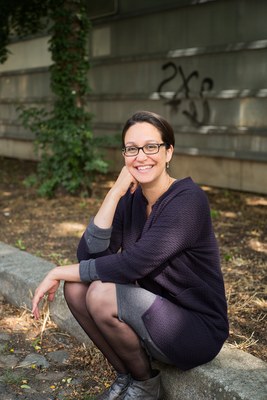Not just random noise
Israeli researcher Smadar Ovadia-Caro, PhD student at the Berlin School of Mind and Brain, analyses the brain’s ability to change after stroke. With her research she aims to understand how different brain areas are functionally connected in order to find more effective treatments for patients with stroke.

Smadar Ovadia-Caro
Figure: Matthias Heyde
Why are you fascinated by neuroscience?
My path into science was pretty unconventional as I studied physiotherapy for my bachelor’s degree and also worked as a clinician. I treated children with severe brain disorders or injuries such as cerebral palsy and other diseases of the central nervous system. It was incredible to witness the progress they made in motoric skills and other functions. I was fascinated by the brain’s ability to reorganize - a phenomenon known as plasticity, and simply wanted to learn more of it.
You are now analyzing plasticity after stroke. What led you to this topic?
During my master studies I explored plasticity in the brains of patients with disorders of consciousness using resting-state fMRI. Disorders of consciousness pose great challenges in correctly diagnosing patients as the main approach to diagnosing conscious state is by following a command correctly. Yet, in some cases patients may be unable to follow the command due to fatigue for example. It is hence important to develop objective measures of awareness to compliment bedside tests. The transition to stroke was mainly based on the methodological approach I use, namely, resting-state fMRI.
How does the measurement of awareness and plasticity after stroke relate?
The majority of early studies in neuroscience were focused on evoked activity in response to specific tasks. Using fMRI for example, a person lying in a scanner has to perform a task related to specific areas in the brain. However, this approach ignores the on-going ‘resting-state’ fluctuations that are evident even without explicit task. Spontaneous fluctuations can be recorded using fMRI and are interestingly not random but rather replicate activation patterns evident during specific tasks. This synchronization between areas even in the absence of tasks - an analysis referred to as functional connectivity - points towards a possible cognitive role of spontaneous fluctuations and has been related to perception. This is naturally of importance for both objective measures of awareness as well as for the study of plasticity following stroke.
What can we learn from spontaneous activity on plasticity after stroke?
Stroke has long been perceived as a localized phenomenon: a blood supply deprivation to a specific area causes dysfunction related to the functional role of that region. However, this approach does not explain recovery of symptoms as well as mismatch between local damage and symptoms. As functional connectivity analysis shows, other areas connected to the local lesion undergo plastic changes and are hence indirectly affected by the stroke causing a network-level disruption. This can explain why for example lesions in different locations can lead to similar functional deficits. The main advantage of rs-fMRI is the ability to explore multiple networks using a single fMRI scan.
If strokes have more than local consequences – how does this change research?
In fact, this has a dramatic effect on both exploring recovery processes as well as matching optimal treatment using for example transcranial magnetic stimulation. We have recently developed a multi-network approach to study plasticity following stroke in order to characterize changes in functional connectivity in more than one functional domain. If we would get a more detailed snapshot of the multiple areas involved in the stroke and the alterations of the connection within each network, we may be able to better characterize symptoms as well as enhance recovery in the form of individualized stimulation protocols.
You are from Israel - what brought you to Berlin?
During my Master’s at the Weizmann Institute I received an Email announcing the Women’s Travel Award from the Berlin School of Mind and Brain, applied and was given a place. I had never been to Germany before, so this one week award was a great opportunity to explore a new place. At the Berlin School of Mind and Brain I met my current supervisors Prof. Arno Villringer and Prof. Elke van der Meer. I immediately thought that these are people I want to work with. The close collaborations between HU, Charité and the Max-Planck-Institute in Leipzig provides exceptional research opportunities, making it possible for us to study large number of patients, already one day after stroke.
How do you experience Germany and especially Berlin in comparison to Israel?
Berlin was an unexpected surprise to me. The first thing I recognized was that the city has a very different pace. Although it’s a big city, with all the cyclists it somehow reminds me of a large kibbutz. Living in Tel Aviv or Jerusalem is like living on a constant highway. On a more cultural aspect, Israel is a small country and as such the mainstream tend to be wide and the margins tend to be small. In that sense, Berlin was a fresh breath of air with all of its huge diversity. No matter how unconventional a lifestyle is - Berlin offers a place for everyone, and I love that. The thing I miss the most here is my big, extended, lively family. Fortunately, I live here with my husband and our twins and we receive regular visits.
